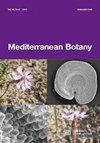一些意大利植被类型的句法名称和选型的验证
IF 0.7
4区 生物学
Q3 PLANT SCIENCES
引用次数: 0
摘要
根据以往植物社会学研究的结果,一项是关于托斯卡纳小栎林的研究,另一项是属于Mulgedio Aconitea的亚平宁群落的研究,以及《国际植物社会学命名规范》第4版中提供的变化,这里验证了四个协会名称,并指定了Senacionion-samniti联盟的选型。本文章由计算机程序翻译,如有差异,请以英文原文为准。
Validation of syntaxon names and lectotypifications for some Italian vegetation types
Based on the results of previous phytosociological works, one concerning the Tuscan Quercus petraea forests, another one concerning Apennine communities belonging to Mulgedio-Aconitetea, and the changes provided in the 4th edition of the International Code of Phytosociological Nomenclature, four association names are here validated and the lectotype of Senecionion samniti alliance here designated.
求助全文
通过发布文献求助,成功后即可免费获取论文全文。
去求助
来源期刊

Mediterranean Botany
Agricultural and Biological Sciences-Plant Science
CiteScore
2.40
自引率
10.00%
发文量
30
审稿时长
12 weeks
期刊介绍:
Mediterranean Botany (ISSNe 2603-9109), formerly Lazaroa, is a biannual journal that publishes original research studies in the field of Botany including plant systematics, vegetation ecology, biogeography, evolutionary biology, ecophysiology, community ecology, ethnobotany and conservation biology on Mediterranean biomes but also in interacting areas.
Mediterranean Botany is an OPEN ACCESS Journal, free of charges for any published article.
 求助内容:
求助内容: 应助结果提醒方式:
应助结果提醒方式:


